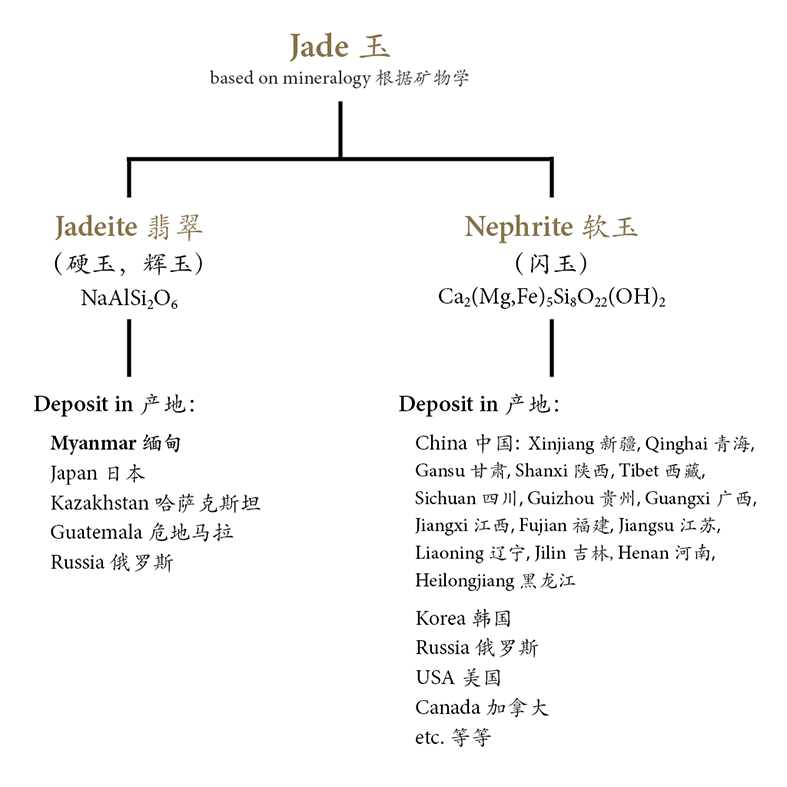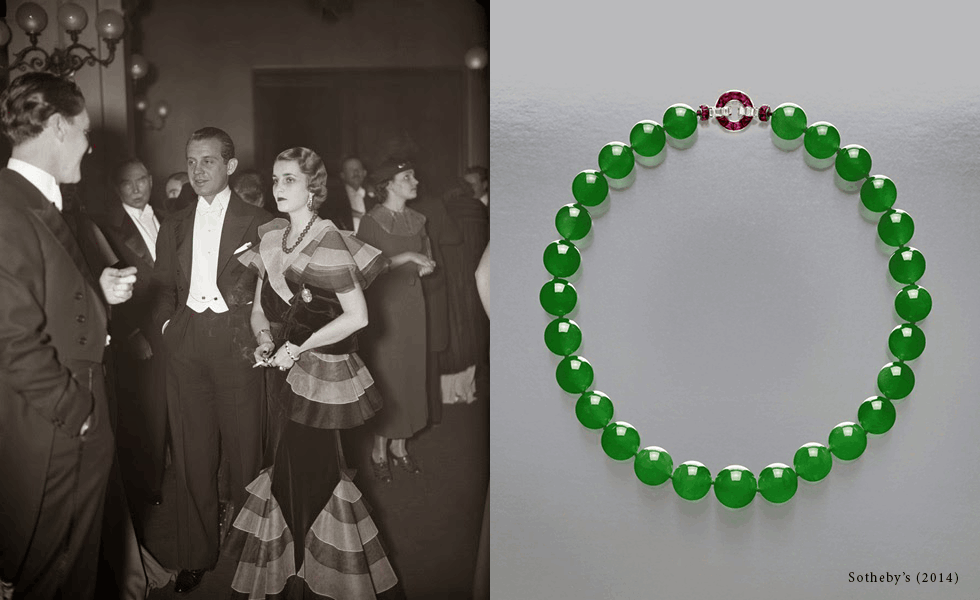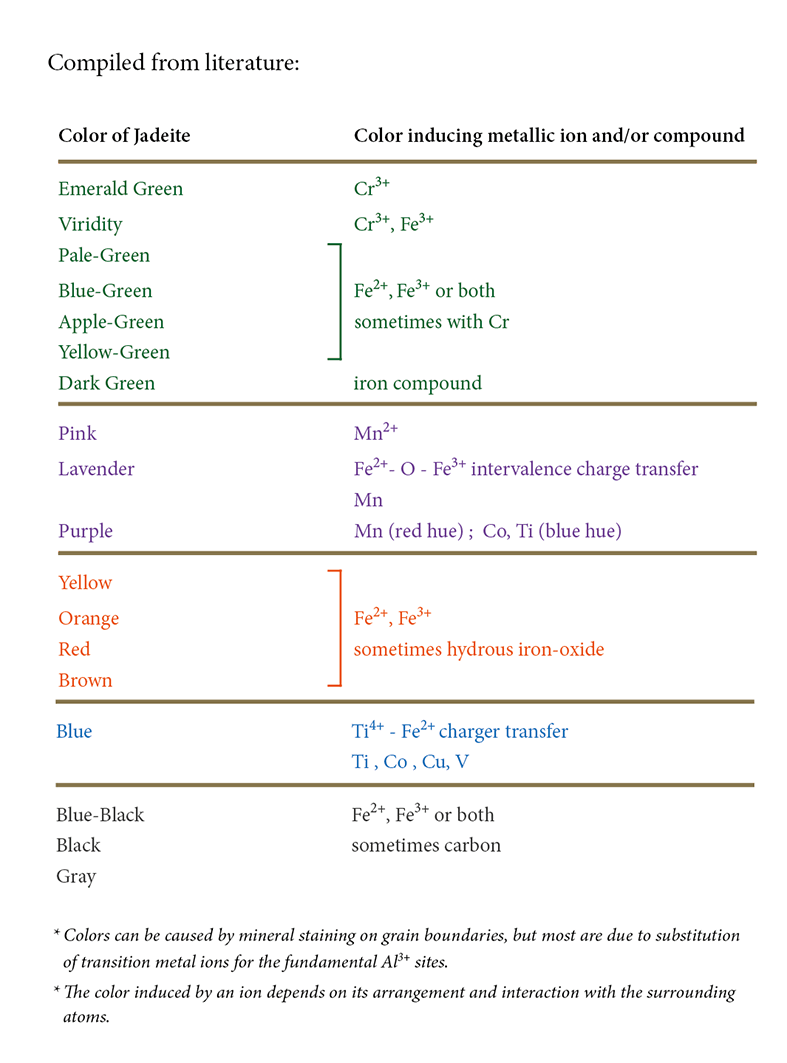
JADE
Jadeite is one of only two minerals that are recognized as jade. The other is Nephrite. Both are actually metamorphic rocks made up of tiny interlocking mineral crystals. It is this microcrystalline structure that imparts both gems with exceptional toughness. They are in fact among the toughest known minerals on earth. Jadeite, lustrously beautiful, is far rarer and more precious.
Prices for jadeite continue to soar over recent years, reaching stratospheric levels for finest pieces. An iconic piece is the record-breaking Hutton-Mdivani Jadeite Necklace. It was sold at Sotheby’s Hong Kong auction in April 2014 for US$27.44 million; more than doubled its pre-sale estimate.

Jadeite and its Colors
The original definition of jadeite in modern days is two Chinese characters – Fei Cui. For centuries in China, it has been a symbol of status and wealth. It is said that Fei Cui was coined after a bird (likely a Halcyon). The bird has beautiful bright-colored feathers, which includes blue, red, green, yellow and others. Fei is a word describing red and Cui a word describing green. They are used together to describe the bright vividness of colors. During Qing Dynasty, the feathers of Fei Cui were well loved and used as adornments in the imperial palace. At the same time (18th century), large quantities of Burmese jadeite, which come in wide range of colors, were first introduced and brought into the palace. The royalties hereafter named the beautiful stones that resembled the colors of the feathers Fei Cui. Jadeite in its ideal form (NaAlSi2O6) is colorless. Over the hundreds of centamegennium of its growth, trace elements from the environment can be introduced into the molecular matrix. Only a small amount is needed to induce color formation. For example, the most priced imperial emerald green is colored by chromium ion (Cr3+). The coloration can also be streaked or mottled. The patterns give jadeite an interesting and unique visual texture. The best colors in jadeite are the ones with accurate hue (with no color modifier), intense saturation, and just the right tone. Ideally, the color distribution should be even to unaided eye. These characteristics are most important in characterizing “emerald green”.

Texture and Transparency
Jadeite’s texture refers to the variation in crystal size. It can be fine, medium or coarse. The texture is closely related to the transparency of the jadeite, which ranges from opaque to near transparent. Usually, the finer the texture, the more translucent is a jadeite. The highly translucent jadeites are termed “icy” and the near transparent jadeites with high clarity are termed “glassy”. The latter being extremely rare and immensely beautiful is the most coveted variety.
Enhancement
High quality jadeite raw is rare and therefore very valuable. Majority of the raw are filled with imperfection. They have inclusions, coarse texture, low translucency, color stained by hydrous iron oxide (brownish) or graphite (grayish), or having excessive fissure. Manufacturers however have found means to artificially enhance their visual appeal.
Commercial jadeite pieces are categorized into three “types” in relation to the treatment done.
Type A Jadeite:
It is jadeite in its natural form. It is usually subjected to a superficial waxing procedure that is known and accepted in the industry.
Type B:
Low quality jadeite, usually having coarse texture and opaque is subjected to a two-step chemical treatment to remove inclusions and stains and to increase translucency. The material, rough or fashioned, is immersed in concentrated acid to remove soluble inclusions and brown iron-containing compounds present in fractures and grain boundaries. Sometimes, a strong base solution is used to further increase the porosity. This bleaching process can last from one to eight weeks depending on the porosity of the material and the severity of the staining. After bleaching, the material’s crystalline structure is grievously compromised as it is filled with voids – no longer tough but extremely brittle. The treatment is also known to leech out the sodium from the matrix. (Note: As mentioned earlier, a jadeite is a silicate of sodium and aluminium.)
The next step is colorless polymer resin impregnation to replace the material lost in the bleaching process. This is done in a pressure vessel, in which high pressure drives the resin into the voids created, fissures or fractures of the material. After this process, the material is somewhat strengthened and translucency enhanced. The polymer resin degrades over time, especially under high frequency exposure to UV (e.g. sunlight), high temperature (e.g. cooking) and mild chemical (e.g. household detergents). The luster of the material will then turn a yellowish hue. Over time, the resin may dissolve entirely, leaving behind the voids and enlarged fissures created during bleaching. The material will loose its luster and the surface becomes matt.
Type C:
This is dyed jadeite. Material with coarse texture is easier for this treatment to be carried out. The material is usually heated and immerse in a pigment bath for weeks. Heat during the dying process facilitates the pigment penetration. The material can be partially or wholly dyed, and at times with multiple colors. Under magnified observation, the artificial color is seen to be concentrated in grain boundaries and fissures. The pigment penetration is also shallow from the surface. These artificial colorings will dull or fade over time.
When the material is bleached, then dyed, and finally impregnated with polymer, it is called Type B+C. In some cases, colored resin may be used.
Imitation and Misnomer
Due to the rarity and high value of quality jadeite, there exist many imitations in the market. Minerals that are hundreds and even tens of thousand of times lower in value than jadeite are being sold as jadeite jade. Common jadeite simulants are: albite, agate, aventurine, chalcedony, chrysophase, hydrogrossular garnet, jasper, quartzite, prehnite, serpentine and even green glass.
There is also another practice where misnomers are given to materials to associate them with the more popular and valuable jade (“yu” in Chinese). This is misleading to unknowing buyers. In mineralogy and gemology, only jadeite and nephrite are considered and recognized as jade. However, there are traders who use the term “jade” loosely on other minerals. Some examples are: “African jade” – hydrogrossular garnet; “Indian jade” – aventurine; “Australian jade” – chrysophase; and some common misnomers in Asia are (in Chinese) “Xiu Yu” – serpentine; “Shui Mo Yu” – albite; “Qi Cai Yu” – picasso onyx (a variety is found to contain nephrite mineral); “Ma Lai Yu” – dyed green quartzite.
Note: From a cultural and social perspective in China, ‘jade misnomer’ is debatable. For centuries, the term “jade” or “yu” has been given to stones that are beautiful. They are seen as artifacts that bring sense of righteousness and virtue to wearers. Although the naming practice has its root, it can be misleading and confusing to many modern days buyers. Both jadeite and nephrite, especially jadeite, not only have the same spiritual value but also have a much higher material value than the other minerals. It makes sense to distinguish them and adopt the international industry norm and term for jade – jadeite and nephrite.
Suggested Reads:
1. Gemological Institute of America
2. Swiss Gemological Institute
3. Sotheby’s
4. Christie’s
END
Follow Us